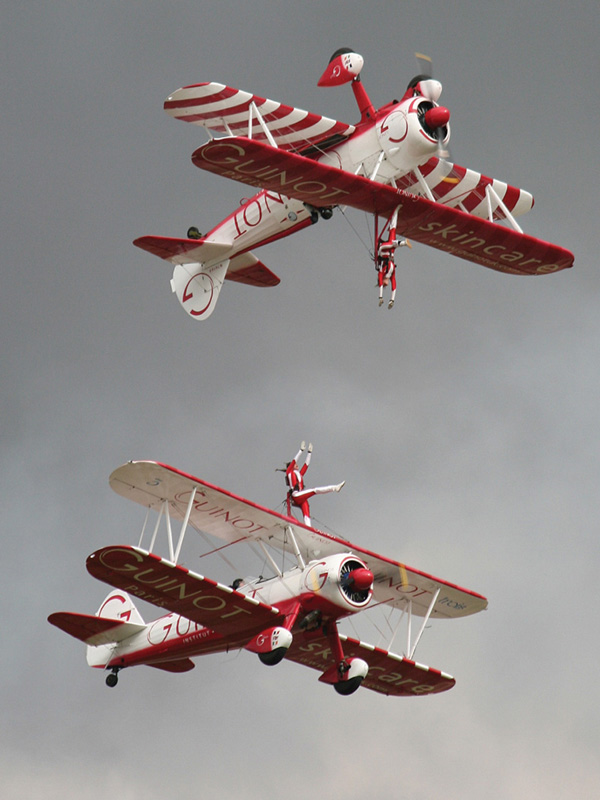
WHAT IT IS A vertigo-inducing mix of acrobatics and aerobatics
WHY YOU WON’T DO IT While adrenalin junkies can buy a taste of the experience, it takes years of training to go beyond simply standing there
For those of us who come out in cold sweats at the mere thought of sitting in a jumbo jet, the idea of being strapped to the wings of a plane, exposed to the raw elements as it sweeps and loops and whooshes through an aerobatic display, is simply terrifying. Can there be many pastimes more insane? Probably not.
The art of wing-walking is generally accepted to have been invented by an American, Ormer Locklear, who had signed up with the Army Air Service during the First World War. In that age of the biplane, mechanical faults were reasonably common mid-flight and Locklear took to fixing them by extricating himself from his cockpit and climbing onto the wings while still up in the air. As other airmen followed his lead, they pushed each other on to ever more extreme exhibitions of showmanship. By the 1920s there was a thriving industry centred around their exploits at air shows and barnstorms.
However, danger was always close at hand. Locklear himself, having become a stuntman in Hollywood, died in an accident in 1920. In later decades the practice was heavily regulated and at times even banned on both sides of the Atlantic but these days you can have a go in the knowledge that safety standards are exacting. As long as you are fit, healthy and game, you can become part of your own aerobatic spectacular.
But keep your expectations realistic – gone are the days of parading up and down the wings, hanging by your teeth and leaping from plane to plane. Now wing-walkers are required to be fixed to a rig. The most talented can still perform tricks such as handstands, but most participants have to settle for standing there and throwing the odd pose.
You don’t need to be an Olympian to participate but consider whether you are physically suitable. You need to have decent levels of strength, balance, flexibility, agility and coordination to manoeuvre yourself onto the plane in the first place and then cope with flying at speeds in excess of 160 kilometres per hour (100 mph). If you suffer from certain ailments or injuries, you will be ruled out altogether. For instance, wing-walking is not suitable for those suffering from epilepsy, head injuries, diabetes, heart problems, dislocations, mental illness or addiction. Most companies also have strict height and weight restrictions. And they will require you to sign a disclaimer in the event of something going wrong!
Age, on the other hand, is no barrier. In 2009 a nine-year-old by the name of Tiger Brewer wing-walked over Gloucestershire in England. The following year, another Briton, Tom Lackey, became the oldest recorded participant at the age of 90.
Work with the experts. There are numerous professional display teams who offer training courses and will ensure you are armed with all the right knowledge and equipment. You can be in the air after just a morning’s training, during which you will be taught essentials such as how the rig and harness work and what hand signals you’ll use to communicate with the pilot.
Make sure you’re wearing the right garb – things get very cold when you’re up in the air, so wear a couple of layers of loose-fitting clothes. Opt for flat-soled lace-up shoes (no high heels, please). Invest in some earplugs and goggles but leave your jewellery at home.
Once you’ve been strapped in, relax your back into the rig and be prepared to experience some curious sensations. During moves such as the ‘zoom climb’ and the ‘run and break’, you are likely to experience facial contortions. In addition, not to put too fine a point on it, if you have any snot to escape, it will! Getting the odd fly stuck in your teeth is another unpleasant occupational hazard, and if it rains, you’ll likely be pelted with ice pellets at high altitude (which normally melt before they hit the ground). So prepare for a split lip – no one ever said this would make you look beautiful.
FORE! Once you’re safely up in the air, there are any number of opportunities for additional stunts. Al Wilson became the first (and seemingly only) man to drive a golf ball from the wings of an aeroplane in flight. Born in 1895, he was a stunt pilot who featured in a succession of early movies until his death in an air show in 1932.